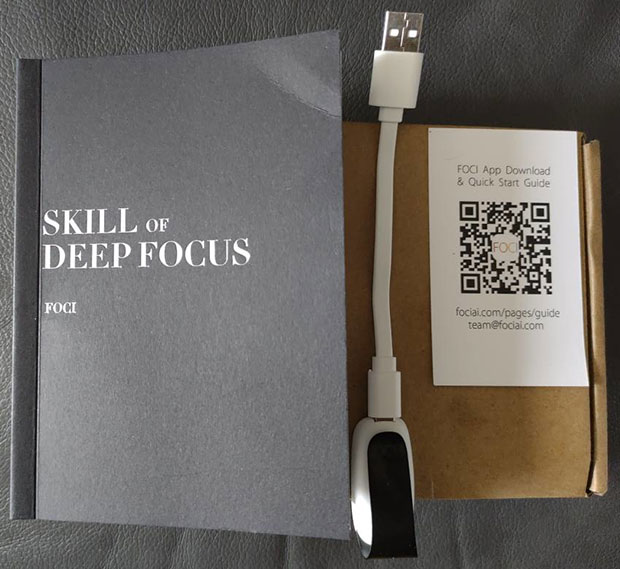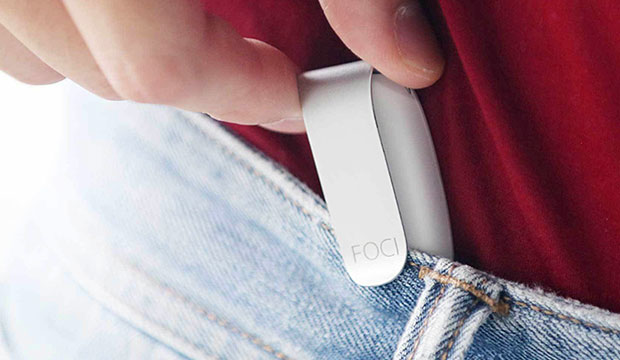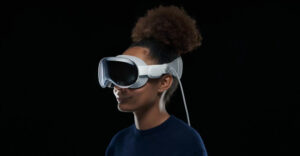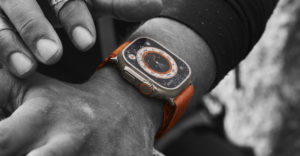Foci is a “Focus Wearable” device by U.K.-based company Tinylogics that combines cognitive biometrics with artificial intelligence (AI) and machine learning (ML) to help you focus better. That combination of technologies presents an eerie yet intriguing approach to help people easily bothered by mental distractions a way to clear out their brain clutter.
Mental distractions may be too broad a term to do this device justice. You can wrap up a lot of human concentration barriers to that general term. This tiny wearable helps you get better control of your wandering focus.
The technology tracks changing emotions caused by a lack of focus, stress, fatigue, and overall daily wellness flow. Getting those under better control helps improve work productivity and overall mindfulness.
This concept is far from new. The Foci sensor device is recently updated but not a new offering. It debuted in 2018 after 20 years of research. The technology, however, follows the latest developments in scientific research and development with how the human brain functions.
Two Cambridge University graduates founded Tinylogics in 2014. Their goal was to greatly improve human life through ‘tiny-logical’ innovations.
As a basis for the Foci device, Tinylogics applied neuro-respiratory science. It takes on the problem of growing digital distractions by helping users discover their optimum mind performance with cognitive biometrics and a personal AI mind coach.
The product page of the company’s website lists the current selling price at US$89.00 with a regular price of $129.00.
Not Voodoo, But Science
The technology behind Foci followed what researchers established about how our breathing pattern is closely correlated with our subconscious, cognitive states. Sensors in the device detect subtle changes in how our breathing changes when we are stressed or relaxed.
The device, which clips onto clothing waistband or a belt, learns our responses and sends an alert when we are focused or distracted. This will be reflected in the tiny movements in breathing that the motion sensor detects. Foci’s developers applied a powerful and agile form of ML to analyze sensor data in real time for everyday use.
Foci captures breathing signals from the slight ebb and flow of the abdomen. For the process to work reliably, you must clip Foci to your waistline with the clip facing outwards. This positions the sensor close to your skin — although thin layers of clothing will not interfere. Bulky clothing, however, does get in the way. So the device comes with a thin fabric belt you can use under bulky clothing.
Hopeful Encounter
Initially reading Foci’s product details gave me a rush. Who would not want a non-toxic, non-invasive method to pump up the mental volume? It seemed like a perfect response to the mental clutter that comes with the aging process.
I also tuned into the use of biofeedback assisted by the AI and ML technological cocktail. Years ago, I had a much more primitive encounter with biofeedback following a serious brain injury. After a near-fatal head smash, I was left with much agitation and reduced focus.
My doctor attached me to a computer in a chilled room via two finger sensors. The monitor displayed a ball bouncing aimlessly off the screen’s edges. My task was to use biofeedback to control the ball’s movement onto a straight horizontal line across the screen.
“How do I do that?” I asked in skeptical disbelief. “That’s for you and your brain to figure out,” the doctor replied as he exited the room.
With only my own smashed intelligence, no machine learning, and numerous return sessions, that ball flatlined! My agitation and mental clutter over time became greatly removed.
Disappointing Experience
At any age, reducing distractibility by controlling procrastination, controlling mental chatter, and channeling better mental focus are skill sets to develop at any age and maintain like taking vitamins. I couldn’t wait to get started.
The directions seemed simple enough. First, I downloaded the smartphone app and set up an account. Then, I inserted the short charging cable into the Foci device and made the USB port connection. The device beeped and vibrated as it was supposed to as it waited for the pairing.
Only the pairing failed. The Bluetooth scanning on my phone reported no available device even though Foci continued to blink as if waiving. But hey, my Samsung Galaxy 8+ was always finicky with connections. So I switched to my Motorola Edge. It too rejected Foci.
Looking for a solution, I sought help on the product’s website. No help there either. A chatbot window that would not go away also would not respond. I would type in my report of a filed pairing, only to have the window close and then reappear blank.
No help forum either. I was able to send an email with the website’s contact form. If I get a response, and the suggested solution works, I will update this review.
Heavy Baggage
The Foci wearable is far from a clip-it-on and forget-it mechanism. You first have to spend some time getting familiar with understanding the information the app provides. To get started, the included 100-page “Skill of Deep Focus” guide booklet presents a lot of sometimes heavy reading.
Then, assuming your app actually connects to the wearable sensor, the various screen displays and graphs need some figuring out. For instance, the app shows colored orbs indicating if you are focused, distracted, stressed, or fatigued.

The color changes as the sensor detects you are becoming more self-aware so you can stay on track. The app also prompts you with lists of suggestions about what you can do to become more focused.
You can even choose to prevent distractions by customizing the nudges. One such option is to have the app use its deep focus mode to change your phone settings. Foci can put your phone into Do Not Disturb mode so you do not get distracted by notifications and you can focus better on the task at hand, such as studying, programming, etc.
Useful Biofeedback
You can easily examine your productivity progress by reviewing the recorded reports the app maintains. Foci’s mind orbs charts your different cognitive states. This lets you compare your time spent in deep focus over time.
A fluid orb on the app screen shows your cognitive state in real time. The orb moves with your breath. It immediately switches color when you get distracted.
The states that Foci tracks are Focus, Calm, Distracted (Not in Focus), Fatigue, Stress, and Flow. Foci shows your progress by displaying three types of screen reports.
Today’s States is the default view. It shows all the streaks you formed throughout the day. Press the orbs to view the streak name, streak length, and when you left the streak.
Past States uses a calendar format to view all your past days’ states from when you started using Foci. This is a good way to see an overview of your clarity and focus progress.
The Deep Focus screen is a summary that tracks your cumulative deep focus, compared to yesterday, a time last week, your weekly best, and your all-time best.
More ‘Star Trek’ Features
Emotion Tracking lets you know every focus, calm, distraction, stress, fatigue, and flow throughout the day for added self-awareness.
Distraction Alert helps you cut short distractions with timely nudges. You can customize five types of distraction nudges to stay on track as you work.
Deep Work lets you set Pomodoro timers to regulate your time on task, view detailed productivity stats on your working patterns, use distraction alerts, and focus music breath pacing to stay focused longer.
Focus Boost lets you focus on your specific work and relaxation biofeedback performance, so you learn to control your attention and become refreshed from fatigue and stress.
You can learn more about Foci on the product website.
Want to Suggest a Review?
Is there a tech product or application you’d like to suggest for review? Something you love or would like to get to know?
Please email your ideas to me and I’ll consider them for a future column.
And use the Reader Comments feature below to provide your input!























































